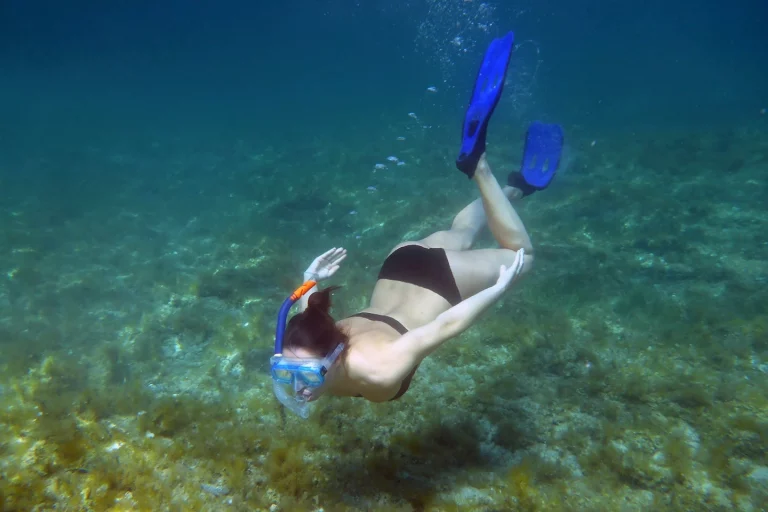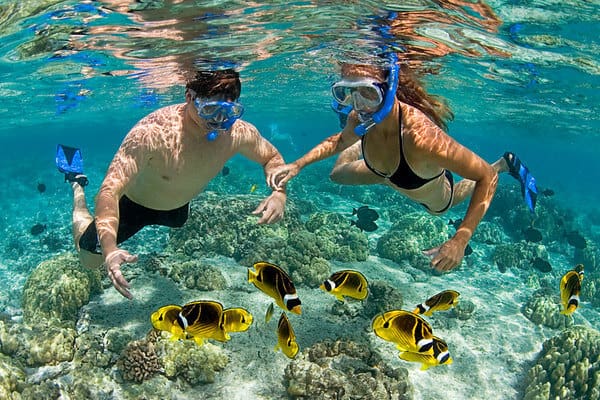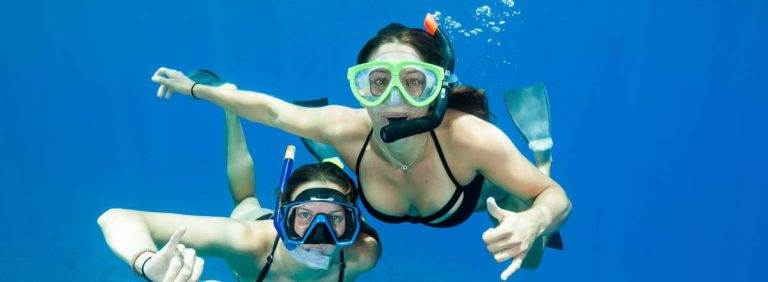Are you looking for a complete guide to snorkeling? In this blog, I will go over the essentials and also discuss the information on guidelines.
Before I begin, imagine yourself peacefully snorkeling around, admiring the beauty of the undersea environment. Then you notice someone fluttering around, half swimming, partly sinking, scaring half the fish away from the water.
Yes, we’ve all been there at some point in life. Don’t be afraid if you’re unfamiliar with it. Here’s some snorkeling guidance to help you avoid feeling like THAT person. Swimming in the open sea may be scary for people who aren’t entirely at ease in the water. Here are a few of our Complete Guide to snorkeling for making the most of your trip at sea to avoid feeling and appearing like an idiot.
What is Snorkeling?
Let’s start with the basics. What is Snorkeling? Snorkeling is described as swimming in or through the water while using a diving mask, a customized breathing tube known as a snorkel, and generally swim fins.

Types of Snorkeling
Surface Snorkeling
Many enjoy snorkeling on the surface of the water and viewing the aquatic realm from a pleasant position. There’s nothing wrong with this, and it’s a large part of many family vacations.
In this situation, we suggest a full-face snorkel mask. If you’ve never used one of these before, you’ll be in for a treat. Check out our snorkeling gear review to learn more about it.
Snorkeling in Deep Water
Snorkeling in deeper waters is a much more exciting experience. Even if you’re only snorkeling on the surface, the experience is entirely distinct. It might be intimidating when you first look down into the depths, and the sunlight rays converge around you and fade into the deep, dark ocean.
My first deep-water snorkeling experience was on a boat several miles offshore in the middle of the ocean. It’s breathtaking. Interacting with incredible marine life is much more excellent, which may be a transformative experience. Check our Article regarding Can you Snorkel While Pregnant?
Snorkel Diving / Snorkeling Under Water
Some people prefer Snorkeling on the surface, but others want to get closer to the action. If you want to snorkel underwater, you’ll need a Snorkel certification.
Several sites offer snorkeling opportunities, including reefs and some wrecks. Check our Article regarding How to snorkel underwater?.
Precautions should always be taken, as described in our safety section below. We do not recommend full-face snorkel masks in this situation, and our article offers a solid reason. We propose using a traditional diving setup.
How to snorkel like a pro (Preparation)

Planning can help you make the most of your next snorkeling holiday and leave the novices in your wake. (You Can Also Check Can I snorkel if I can’t swim?)
Improve your swimming
Participate in swimming lessons at your local pool if your swimming abilities are poor. Even if you’re a strong swimmer, enhancing your skills may give you an edge in the water.
When snorkeling, concentrate on the freestyle since the kicking technique from that style will be utilized.
“Improving your strength and stamina in the muscles involved in the kick will allow you to snorkel more frequently and with less effort, allowing you to appreciate the environment more. Being a strong swimmer will also allow you to avoid wearing the Snorkeling vests that most people wear when snorkeling.
On the other hand, a snorkeling vest provides flotation but restricts your movement in the water. And you are making it more challenging to go diving to view a reef or fish.
Swimming skills will keep you safe in the water.
Practice
Swimming with fins is an entirely different experience. The added drag and weight of the fins put extra stress on the muscles, which is why you may feel cramping if you haven’t used fins before.
So, get your snorkeling fins out and go for a dip at your neighborhood pool or in your backyard. Mix it up by doing long and short stretches at a moderate speed.
Improve your breath hold
Some snorkelers stay at the surface and utilize the snorkel to breathe while looking down. On the other hand, a few more experienced snorkelers explore skin-diving territory by doing brief dives below the water’s surface while holding their breath.
You may take advantage of this to get a closer look at the marine life, and you’ll be able to explore reefs and other underwater features up close. You can also improve your breath-holding capacity and swimming efficiency to make the most of your time beneath water.
Consult your local freediving club for hands-on training and practice to acquire more expertise. With the growing popularity of freediving, these are becoming increasingly accessible.
Conserving Energy While Snorkeling
Swimming in a tropical sea may not seem like much of an activity, but don’t be fooled: Snorkeling can take it out of you! Even in very hot water, your body loses heat continuously due to water’s greater heat capacity than air.
It also takes energy to push yourself forward with fins on. Add to this that snorkeling activities can last multiple hours, and you’ll understand why conserving your energy is crucial!
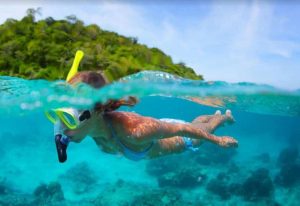
“Like scuba diving, remember to take it easy, relax, and let your fins do the work for you. Taking the time to unwind your body and mind is a major step in accepting water as a new experience for most people.”
Like in a pool, many new snorkelers try to swim with their arms. But our legs, particularly fins, easily outperform our arms many times. So a fantastic technique to save energy is to keep our arms at our sides and focus on our fins instead of swimming with them.
Be sure to keep your legs moving, too; a slow foot movement is enough to propel you forward, and if you move too quickly, you’ll zip past exciting views. Plus, if you kick too hard and flail with your arms, you’ll create a lot of splashing that will frighten away the birds you came to see!
Conserving your air while snorkeling
Take a long, deep breath. Breathing through a snorkel can be pretty different from breathing without one. Taking big breaths is beneficial in several ways, and it also helps you relax and conserve energy by keeping your heart rate down.
Snorkeling deep
Some snorkelers prefer to stay on the surface during their dive and should do so.
Others would like to go deep on a breath-hold to be closer to reefs, sea life, or other elements in the depths. There are a few things you can do to get the most out of your single breath:
First and foremost, relax. Take a few breaths to relax and center yourself before diving into the depths of your mind.
Then, take a few deep, controlled breaths.
“Don’t hyperventilate! This was taught on scuba courses years ago, but it has been demonstrated ineffective.”
While counting to four, breathe deep and slowly to fill and empty your lungs. Take a deeper breath next time, making sure to fill up your diaphragm first before the chest and then the top of your torso. When ready for your drop, bend your body at the waist and submerge it while keeping it vertical in the water.
Raise your leg so that it’s also vertical but above water. You will sink into the water as your legs grow heavier, saving you energy. When your fins enter the water, use them to add depth.
This is a far more effective approach to swimming up than the common snorkeling ascent you see novice divers attempt.
Once you are underwater, relax.
Slowing down and relaxing, however, is all it takes for most individuals to improve their breath holds. Swimming slowly and efficiently to streamline your body and focus on each movement moving you forward.
On the side of caution, err on the safe side. Come up well before you run out of air and gradually extend your bottom time each time you go under. Soon, you’ll have a feeling for how long you can stay down comfortably, and most likely, it will be considerably longer than your first underwater excursion.
Snorkeling equipment: What you need and what you don’t
Expert advice: Get your snorkeling equipment early to get the right fit!
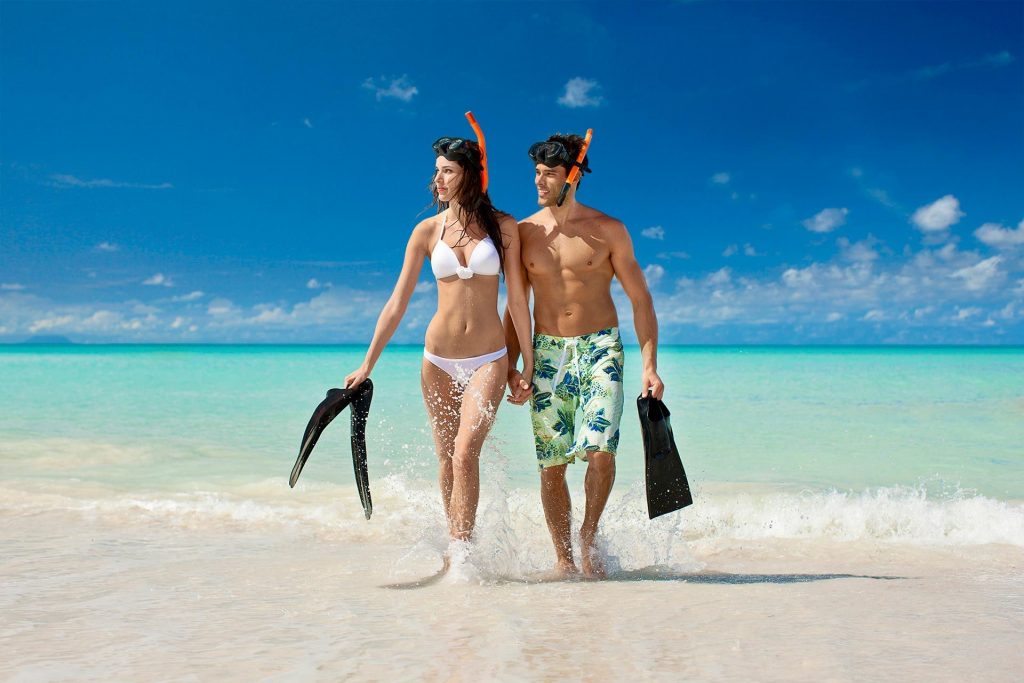
The first two steps to a fantastic snorkeling experience are to be mentally prepared and have the necessary equipment. Personal belongings can enhance your trip, but they may also add weight. Keep in mind that you should only bring things that are truly necessary on the journey because valuable items can get lost or stolen. (You Can Also Check our separate Post regarding What snorkel gear should I buy?). Before you go, here’s a rundown of the gear and terms you’ll need to know:
- Diving mask/goggles – These are critical, and they’ll take some getting used to. Snorkeling/diving masks keep the water out of your eyes and allow you to view the amazing aquatic life below.
- Swim Fins – Fins can help you save energy while swimming and help you swim faster. Fins might also come in useful if you’re swimming against a current. As a result, they’re worth investing in or renting out for these reasons.
- Wet suit/dive skin – Ideal for retaining warmth or shelter, especially in colder seas. There are a variety of sizes (short or full length) available.
- Booties – Flat boots are ideal for scuba diving and Snorkeling since they offer excellent ankle support.
- Flotation device – A flotation device, such as an inflatable snorkeling vest, is suggested for extra safety. Make sure it inflates or deflates quickly.
- Snorkel Keeper – The diving mask is connected to the snorkel with a quick-release clip that keeps them securely linked.
- Snorkel – To ensure that you may stay underwater for long enough to enjoy the views, there’s a tube with a distinct curve to it!
- Dry Snorkel – The waterproof mouthpiece is designed to keep water out. The main goal of a dry snorkel is to keep water from entering the snorkel. It’s not meant to allow you to breathe underwater like a scuba tank.
- Purge valve – The purge valve found within a snorkel makes it much easier for water to flow back out of the snorkel.
Five best snorkeling tips: It takes a few simple tips to snorkel like a pro!
1. Find the perfect fit for your mask
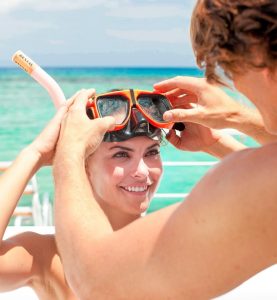
First, put the mask over your eyes and wrap the elastic around your head. Check for twists and ensure the straps are flat above your ears.
Remember that the mask should not be worn at the base of your head, as the mask may slip out of position and allow water to seep into it. The mask strap should fit comfortably around the widest point of your head.
One of the essential snorkeling rules to keep in mind is this one. Before you go out, you can do a few things to ensure your mask fits your face correctly.
Press the mask to your face and breathe in through your nose barely. If the mask fits securely to your face as soon as you let go, that’s an indication you’ve got the right size, but don’t tighten it too much.
A tight-fitting mask might cause a headache or general discomfort, and more importantly, the pressure from the mask as soon as you enter the water helps to keep it in place. Remember that mustaches and hair can become caught in the snorkeling mask’s proper fit. To avoid leaks, brush your hair away and out of your face while snorkeling. Leaks can be sluggish and steady, so practice the ‘mask test.’
2. Defog your mask with baby shampoo or defogging gel
The most important thing you need to know as a novice is how to defog your mask, which is perhaps an essential skill. Serious snorkels often use baby shampoo as a defogging solution. Some gels may be purchased at resort or dive shops that may be used to keep your mask from fogging up.
Remember, when snorkeling, visibility is crucial. Defogging solutions work by forming a barrier between the air moisture in your mask (your breath) and the mask’s glass. Check out How to clean a snorkel tube: 3 quick steps & 2 surprises.
3. Get excess water out of your mask when needed
Understanding how to remove water from your snorkel mask is vital to enjoying your experience. It’s preferable to master this before going into the sea.
There are various methods to keep your snorkeling mask clear of water, although it is feasible to remove the extra water from your mask underwater if you want. Remember that if your mask fills up with water, do not panic. You can always come up for air to remove the water.
If you’ve seen something extraordinary and don’t want to risk missing out, you’ll need to know how to clear your mask underwater rapidly. Pull the bottom of the mask away from your face and blow outward to release the water.
Take a deep breath, make sure you’re comfortable, and unwind. Check to see if your mask is leaking before submerging again. Always double-check that your mask is fitted correctly! Check this out How to clean a snorkel mask & easily prevent fog and damage
4. Preserve energy with full-foot fins

There’s no doubt that fins increase underwater mobility, making the experience more exciting. Beginners must choose between full-foot or adjustable fins, and experts won’t want them to do so.
When it comes to fins, full-foot fins are usually the best option for novices. Before you go, make sure you get the right size. Avoid using fins that are too tight, loose, or painful.
Slide into the shallow end of your practice pool, or do the ‘moon walk’ carefully across the sand into the ocean to an area where water is deep once your fins are on firmly. Going for a test run before diving about is usually a good idea.
5. Take deep, focused breaths to help yourself relax
When scuba diving or Snorkeling, deep breathing is the key to life… or at least it is when you’re scuba diving or Snorkeling. Breathing might be restricted by a snorkeling tube, so take deep breaths to relax.
Do’s and Don’ts for Snorkelers:
Don’t snorkel alone
If you’re new to this, get in touch with a more experienced buddy. Even though Snorkeling is relatively safe, you are still in the open sea where hazards such as currents, jagged reefs, and animals can harm you.
Don’t touch anything
Even if it appears to be the most innocent-looking fish, do not attempt to pick it up. The same goes for attractive sparkling corals or sea anemones. Even if you touch the tip of your finger to a fish’s fin, some marine creatures can be alarmed. Please keep your hands to yourself and avoid picking things up and touching them.
Don’t panic
If you’re feeling nervous, don’t grab the first person you see. Instead, float on your back, breathe deeply and shout for assistance. If you aren’t quite ready yet, grab a life jacket to make the experience a lot more pleasurable!
DO get to know your surroundings before venturing out.
Check with local authorities or other persons who have experience. Inquire about riptides and strong currents. Is there anything in the water that you could wash up on?
Spend some time getting to know your surroundings. Hopefully, this advice in this article will help you avoid appearing like an idiot flailing about in the open water. Relax and be cautious; have fun with it. The secret to Snorkeling is to unwind and enjoy it fully.
Safety precautions for Snorkeling
Important: Accidents are preventable if you are vigilant and well-informed.

It might be challenging to discover accurate snorkeling tips that don’t frighten you away from the water, but it’s critical to learn. The majority of snorkeling risks are due to people not following regulations. It may be you or others nearby, but it is in your best interests to remain vigilant.
“Wear a life vest, pay attention to your guide, and you’ll have a fantastic time.”
- Pay attention – Videos and pictures are lovely, but avoid doing this while safety training continues. It’s vital to preserve memories, but it’s more essential to be safe. (Snorkeling Photo Tips)
- Use safety equipment – It is strongly suggested that snorkelers use floatation devices. Inflatable vests are not only for people who don’t know how to swim but might also help you survive if you become exhausted. Vests may be inflated by mouth for greater buoyancy. A release valve also allows snorkelers to dive to the bottom to inspect fish and other marine life at greater depth levels.
- Never snorkel alone – For beginners or even more experienced snorkelers, having a companion is suggested. A snorkeling buddy adds to the experience – they’re also close by if something goes wrong.
- Look but don’t touch – Consider it a virtual travel experience. Avoid touching the marine life and in no way attempt to bring anything back with you.
- No sinking, swimming only – Although Snorkeling is a fun and exciting activity, it may also be difficult to make the most of your experience if you don’t know how. Floating vests, like inflatable ones, are advised. Water noodles can also be used as a recreational floatation device while snorkeling in an informal environment.
- Know your equipment – If necessary, practice in a swimming pool. Practice with your gear beforehand to boost your confidence. If you don’t have access to a pool, any shallow body of water with little movement will work.
- Weather conditions matter – Before you go, check the weather forecast. Snorkeling is best when the seas are calm and smooth. It’s important to note that weather patterns can alter as the hour’s pass. Even under optimistic expectations, it’s critical to check for yourself whether the seas are suitable for Snorkeling. If you take a lunch break, ensure the waters are okay before resuming your snorkeling activity.
- Know your location – Learn all you can about the area you will visit. Come up for air on your snorkeling trip to see what’s happening around you. This can also help you track where you are because tides may sweep you out to sea. Keep an eye on the surf and ensure there isn’t much wave action. Follow all safety regulations and be cautious.
- Know your limits – Once you’ve entered the water, remember that it’s vital not to go overboard. It’s a brand new experience; take it one step at a time. Some novice snorkelers have said they could not complete the course because they were too overwhelmed. Tell your tour guide if you are too weary of completing or don’t feel comfortable. If you’re on a private trip with a snorkeling buddy and want to leave, tell them and return together.
- Undersea dangers – The most dangerous animals to watch out for include barracudas and sharks, but you are unlikely to come across any of these in your location. Find out more about the typical inhabitants before settling on a site. Lionfish, an invasive species from the Indo-Pacific, and jellyfish are two other possible hazards. Lionfish are typically safe and only sting in self-defense situations. They may appear frightening to novices since they have poisonous spikes that can be deadly if you get too close. Jellyfish, on the other hand, travel in schools, and stings might produce tiny itching red marks. Giant jellyfish may be more dangerous but are not usually seen on snorkeling expeditions.
- Secure your belongings – Whether you leave your personal belongings on a boat or on the beach, be sure they are in good hands. The dive shop is usually the best spot to store these, and it’s safest to keep valuables at home!
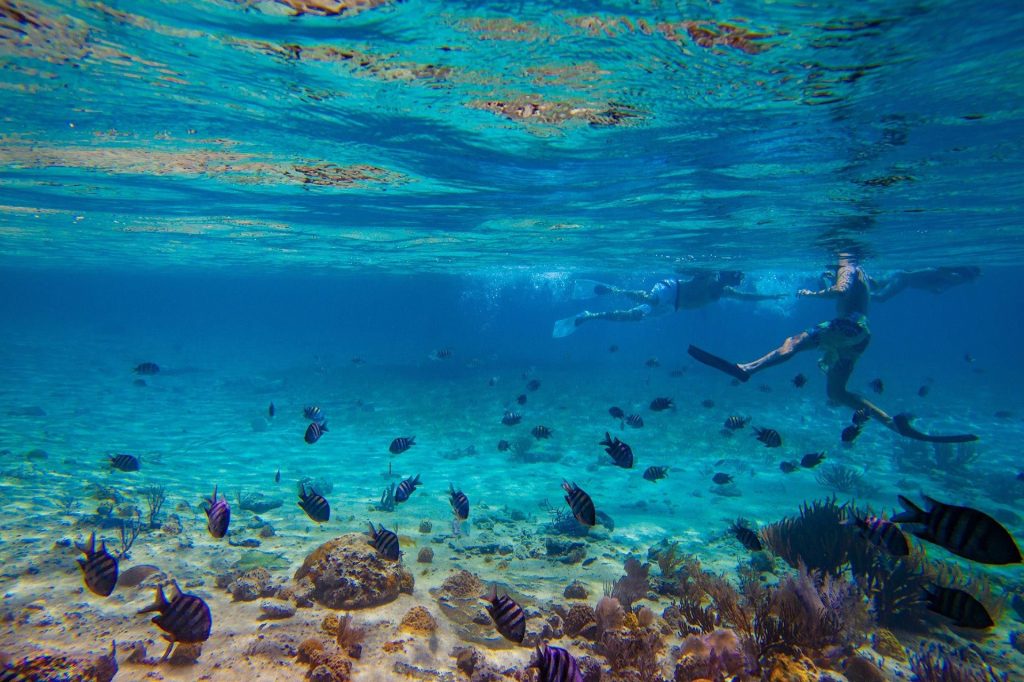
Complete Guide to Snorkeling Conclusion
Snorkeling is one of the thrilling outdoor hobbies that are not only very simple to master but also wonderful for the vast majority of individuals. You are ready to find sea turtles, native reef fish, and other beautiful things now that you have the information necessary to enhance your experience. Create a tour to discover the wondrous sights and hidden mysteries of the undersea world in all its splendor.
So, what are the most important things you should remember from this guide to snorkeling? Having the proper equipment and familiarity with the area you want to snorkel in will make for a more enjoyable experience.
- Practice! The best way to improve your swimming is to swim more.
- Perform several practice breaths while using the snorkel.
- Get in the habit of using full blast to empty your snorkel.
- Get some underwater practice so you can get a better look at the reef.
- Developing these abilities via repeated practice will provide enormous benefits.
Relax! The last one will emerge naturally from my previous two. Preparedness and familiarity with your snorkeling gear will allow you to take it easy throughout your outing.


